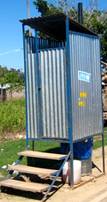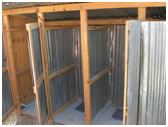On This Page
Sanitation Solutions in Emergency Response Settings
Overview
- Lack of adequate and appropriate sanitation and hygiene access can be chronic public health challenges contributing to disease transmission in low- and medium-income countries. This situation can be further exacerbated during environmental disasters and environmental and public health emergencies.
- In response to disasters and emergencies, prevention of indiscriminate open defecation and containing waste is critical to reduce disease transmission.
- While planning for long-term waste management, immediate sanitation solutions are often needed to minimize public health impact during emergencies, and should include sanitation facilities, hand washing facilities with soap and water, operation and maintenance regimes, operator training, and community education. Sanitation options are discussed below.
Sanitation Solutions (Immediate Term)
Packet Latrines

Individual, single-use biodegradable bags for point-of-use sanitation that are buried or properly disposed.
- Bags typically inside reusable buckets
- Brand names: Peepoople, Wagbag
Advantages
- No infrastructure required
- Lightweight and easy to transport
- May be used where space is severely limited or in flooded areas
Constraints
- Active supply chain needed to provide </=1 bag/person/day
- High costs of some types of bags
- Need for disposal site and possibly collection services
- Potential for bags to be discarded in open areas or areas posing risks to others
- Social acceptance varies and would need to be determined for target population
- Requires intense hygiene campaign to educate the community on handling and disposal of bags
Bucket Latrines or Elevated Toilets

Elevated temporary structure over large container or tank that can be lined with large, replaceable plastic bag.
Advantages
- Large containers typically easily procured
- Suitable for sites where digging of latrines is not feasible or suitable.
- Well suited to areas with high water table or where flooding occurs
- Larger tank requires less frequent emptying
Constraints
- Requires tanks and superstructure
- Requires desludging trucks and personnel
- Need for sewage disposal site
- Vehicle access required to empty containers
- Social acceptance varies and would need to be determined for target population
- Requires intense hygiene campaign to ensure bags are buried/disposed and containers sanitized
- May be difficult to access for handicapped, elderly and small children
Chemical Toilets

Portable prefabricated sanitation units with water-tight excreta-holding tank, containing a chemical solution to aid digestion and reduce odour.
Advantages
- Portable
- Hygienic
- Minimize odor
- Can be mobilized rapidly
- Demonstrated success in the Dominican Republic 2003 flooding
- Well suited to areas with high water table or where flooding occurs
Constraints
- High cost
- Difficult to transport
- Requires desludging trucks and personnel and disposal sites
- Vehicle access required to service toilets
- Require frequent emptying due to small size of tank
- Need for sewage disposal site
- Uncommon outside Europe, North America, and parts of Latin America
Trench Latrines

Narrow trenches with temporary privacy structure; waste covered daily with soil.
Advantages
- Rapid to implement (one worker can dig 50m of trench per day)
- Feces can be covered easily with soil
Constraints
- Short life span
- Flooding of trenches during rainy season
- Drainage to divert surface water from trench required
- Constant management required to ensure covering of wastes daily
- Limited privacy
- Unsuitable where water table is high
- Odor problems
Communal or family pit latrines with short-term structure

Shallow pit of approximately 0.3m x 0.5m x 0.5m depth with simple privacy structure; waste covered with soil when latrine is near-full.
Advantages
- Increased privacy
- Rapid to implement
- Reduced labor input
- Higher-level of user involvement / ownership
Constraints
- Require adequate space for digging of pits
- Rainy season may pose issues with flooding of pits
- Unsuitable where water table is high
- Pit latrines fill-up and need to be capped long-term
- Large quantity of tools and equipment required
- Community must be able and willing to construct latrines
Other Sanitation Solutions for Accustomed Populations
or Agricultural Communities (Immediate Term)
Ecological Sanitation Latrines

Elevated structure over container or bin which stores organic waste for decomposition. Dehydrating toilets divert urine from organic waste and require bulk drying and pH additives. Non-urine diverting toilets collect all waste for decomposition and require the addition of organics.
Advantages
- Minimize odor
- Well suited to areas with high water table or where flooding occurs
- Decomposed organics can augment top soil and fertilizers in agriculture
Constraints
- More difficult to construct
- High level of user awareness required
- High level of management required
- Consumables required (ash/lime and/or organics)
- Complex to operate and maintain
- Requires intense hygiene campaign to ensure proper use
Recommendations for Sanitation in Improvised Settlements and Cholera Prone Areas
- Chemical toilets should be used in the immediate term where available and where the means to service them adequately exists.
- If chemical toilets are not feasible, trench latrines or temporary pit latrines should be constructed immediately where no toilet facilities exist.
- Elevated latrines should be considered for areas where digging of latrines is not possible or acceptable or areas with high water table or prone to flooding. They have larger reservoir and need to be desludged less frequently than chemical toilets.
- The Sphere standard of 50 people per latrine for emergency situations should be used for the immediate term, with the aim of decreasing to the Sphere minimum standard for excreta disposal of 20 people per latrine.
- Residents of IDP settlements should be engaged in choosing among appropriate alternatives.
- Existing practices should be further investigated to identify other feasible alternatives (e.g., are people in improvised settlements using toilets in minimally damaged buildings in the vicinity?).
- Further investigation of the local feasibility and local acceptability of packet and bucket latrines should be undertaken.
- Health communication materials should contain information about latrine use and care (in local languages), and provisions made to communicate with non-literate populations.
- Longer term sanitation solutions should be investigated further to help prevent recurrence of cholera and other infectious diseases.
- Regardless of the type of sanitation facility installed, handwashing stations should be installed at every sanitation facility.
References and Additional Information
GTZ. Technology review of urine diversion components (2011). [PDF - 32 pages]
WHO. Guidelines for the Safe Use of Wastewater, Excreta and Greywater.
Get email updates
To receive email updates about this page, enter your email address:
Contact Us:
- Centers for Disease Control and Prevention
1600 Clifton Rd
Atlanta, GA 30333 - 800-CDC-INFO
(800-232-4636)
TTY: (888) 232-6348 - New Hours of Operation
8am-8pm ET/Monday-Friday
Closed Holidays - cdcinfo@cdc.gov


